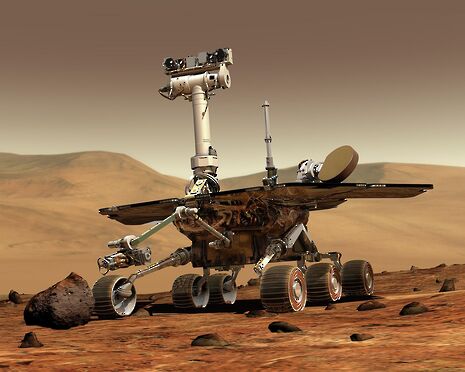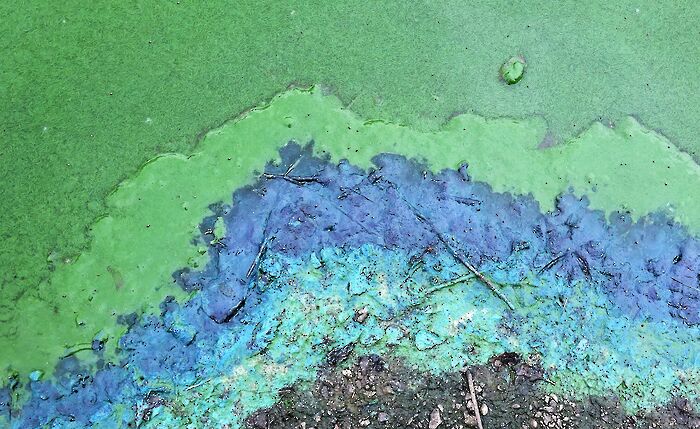Goodnight Opportunity, hello Franklin
As we bid farewell to NASA’s Opportunity Mars Rover, Jess Sharpe looks back on its groundbreaking achievements which have laid the foundations for future exploration and discovery

“My battery is low and it’s getting dark” was supposedly the final message sent back to mission controllers on Earth by Opportunity. On 13th February, NASA declared the Mars rover mission over, after failing to make further contact with the rover following a vast dust storm that cut off communications last June. Over 830 attempts to establish contact were made. The affectionately nicknamed ‘Oppy’ outlived its intended mission lifetime by over 14 years, changing our understanding of the Martian landscape as the third robotic explorer on Mars – and taking its first selfie.
Oppy landed on Mars in 2004 in a crater full of spheres of the mineral hematite. On earth, these typically form in water. Other evidence for the presence and qualities of water on Mars were swiftly identified, from the discovery of the mineral jarosite that forms in acidic water to crossbeds which indicated that water had once flowed across the planet’s surface. The evidence of water’s presence has helped to identify promising sites for future missions, and enabled us to begin determining whether Mars could ever have supported life.
“Oppy exceeded expectations with its lifetime and discoveries”
There was great adversity during Oppy’s 15-year mission, alongside these huge triumphs for science. Oppy travelled more than 28 miles across rugged terrain through dust storms and sand ripples, with routes plotted by teams of mission engineers. The last contact with Spirit – the other Rover on NASA’s Mars Exploration Rover mission – was in 2011, yet still Oppy wandered on. Both of these rovers far outlived their 90-day mission lifetime, and contributed vastly to our understanding of the Martian environment. It is clear now that the cold and dry Mars of today is very different from its ancient past, with water above and below its surface that could have once sustained life forms.
Oppy exceeded expectations with its lifetime and discoveries, and set new precedents for Martian exploration. Currently Curiosity is the only rover on Mars, continuing the search for evidence of ancient life. Soon two new rovers will join this astrobiological quest. These missions will investigate areas identified as having potentially been habitable, as well as begin investigations in preparation for future human expeditions to Mars. Rovers therefore have a key role to play in improving landing techniques and investigating environmental conditions that will affect future astronauts.
In July 2020, two new rover missions will launch for Mars. Each will set out to discover signs of past microbial life, with on-board spectrometers which are capable of detecting ‘biosignatures’. NASA is currently producing the Mars 2020 Rover, while a collaborative European and Russian programme, ExoMars, constructs another robotic rover.
On 7th February, the ExoMars rover was named Rosalind Franklin, which is fitting for a rover off to hunt down traces of ancient life – its namesake Newnham College alumna made key contributions not just to the discovery of DNA but also to scientific work on RNA, viruses and even graphite.
It is also fitting that in the last year of Franklin’s life, she had marvelled at the very beginning of space exploration marked by the Soviet Sputnik satellite. Perhaps Rosalind Franklin will be the first to discover life on Mars: a worthy tribute to the endeavours of space science as well as a talented and underappreciated scientist.
 Comment / Plastic pubs: the problem with Cambridge alehouses 5 January 2026
Comment / Plastic pubs: the problem with Cambridge alehouses 5 January 2026 News / Cambridge businesses concerned infrastructure delays will hurt growth5 January 2026
News / Cambridge businesses concerned infrastructure delays will hurt growth5 January 2026 News / New movement ‘Cambridge is Chopped’ launched to fight against hate crime7 January 2026
News / New movement ‘Cambridge is Chopped’ launched to fight against hate crime7 January 2026 News / Uni-linked firms rank among Cambridgeshire’s largest7 January 2026
News / Uni-linked firms rank among Cambridgeshire’s largest7 January 2026 News / AstraZeneca sues for £32 million over faulty construction at Cambridge Campus31 December 2025
News / AstraZeneca sues for £32 million over faulty construction at Cambridge Campus31 December 2025









